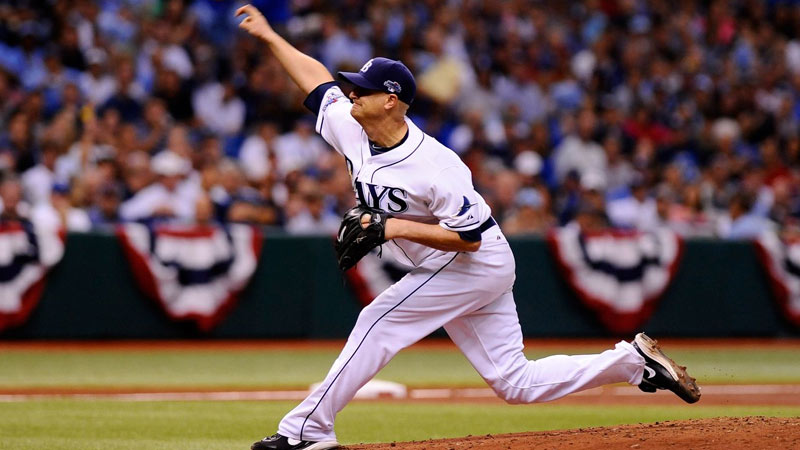The rising fastball is a deceptive and powerful pitch that can leave batters swinging in vain. When executed correctly, it appears to defy gravity, fooling hitters with its unexpected rise.
If you’re an aspiring pitcher looking to add this impressive weapon to your arsenal, you must learn how to throw a rising fastball pitch.
In this article, we will guide you through the steps and techniques required to throw a rising fastball pitch with precision and effectiveness.
How to Throw A Rising Fastball Pitch?
Throwing a rising fastball pitch in baseball can be a challenging technique to master, but with practice and proper mechanics, you can improve your chances of executing it effectively. Here’s a step-by-step guide on how to throw a rising fastball pitch:
Grip the Ball
Start by gripping the baseball with a four-seam fastball grip. Hold the ball across the horseshoe-shaped seams, using your index and middle fingers to apply pressure on top of the ball. Your thumb should be positioned directly underneath the ball for support.
Find Your Release Point
Determine the appropriate release point for your desired location and trajectory. For a rising fastball, the release point should be slightly lower than your usual fastball release, as this will help create a backspin on the ball.
Maintain A Firm Wrist
As you prepare to throw, keep your wrist firm and cocked back slightly. This will help generate the necessary backspin and upward movement on the pitch.
Focus On Arm Speed and Velocity
The key to a rising fastball is generating enough arm speed and velocity. Utilize proper mechanics, such as a strong leg drive and explosive hip rotation, to generate maximum power and speed.
Maintain A Consistent Arm Slot
Aim to maintain a consistent arm slot throughout your delivery. This will provide consistency and control while maximizing the upward movement of the pitch. Avoid dropping your elbow or changing arm angles during the throwing motion.
Drive the Ball Forward
As you release the ball, focus on driving it forward with a firm wrist and a slight snap at the end. This snapping motion will help create a backspin, which in turn generates the illusion of a rising fastball.
Follow Through
After releasing the ball, continue your motion by following through completely. Maintain good balance and finish with your throwing arm coming across your body and your front shoulder pointing toward the target.
Practice and Refine
Throwing a rising fastball takes practice and repetition. Work consistently on your mechanics, arm speed, and release point to develop a feel for the pitch. Experiment with different grips and arm angles to find what works best for you.
A rising fastball is more about creating the illusion of upward movement rather than defying gravity. With practice, you can develop a fastball that appears to rise to hitters, making it a valuable addition to your pitching repertoire.
Additional Tips to Precisely Throw a Rising Fastball Pitch

Source: baseballbible.net
Want to master the rising fastball pitch? Here are a few additional tricks you can incorporate when throwing a rising fastball pitch:
Vary Your Pitch Location
While the rising fastball is commonly associated with high fastballs, you can also surprise hitters by throwing it at different locations. Mix up your pitch placement by aiming for the upper corners of the strike zone or even starting the pitch at the hitter’s letters before it rises out of the zone.
Change Eye Levels
Use your rising fastball strategically to change the hitter’s eye level. By throwing a high fastball followed by a breaking pitch or a lower fastball, you can create deception and make it harder for the batter to time their swing effectively.
Work On Your Timing
Pay attention to your timing when throwing the rising fastball. To maximize the effect, try to release the pitch slightly later than your usual fastball. This timing adjustment can give the appearance of a rising ball to the hitter, as they expect it to drop but see it stay up in the zone.
Utilize Fastball Tunneling
Combine your rising fastball with other pitches that have a similar release point and initial trajectory, such as a slider or a cutter.
This technique, known as fastball tunneling, can make it difficult for hitters to differentiate between the pitches until it’s too late, adding an extra layer of deception to your arsenal.
Change Speeds
While the rising fastball is typically associated with power and velocity, you can also experiment with varying speeds. Occasionally mixing in a slightly slower-rising fastball can disrupt the hitter’s timing and increase the effectiveness of the pitch.
Use It As A Setup Pitch
The rising fastball can be an effective setup pitch to complement your other pitches. By establishing the high fastball early in the count, you can set up secondary pitches like a breaking ball or changeup that starts in the same location but break downward.
This can catch hitters off guard and lead to swings and misses or weak contact.
Remember, these tricks should be used strategically and sparingly to maintain their effectiveness. Practice them in different situations and adapt them to your pitching style to maximize their impact on the game.
When Do You Throw A Rising Fastball?

Source: draysbay.com
A rising fastball is typically thrown in specific situations to exploit the tendencies and weaknesses of hitters. Here are some common scenarios where throwing a rising fastball can be effective:
Two-Strike Count
When you have two strikes on a hitter, a rising fastball can be a valuable pitch to use. It can be particularly effective against aggressive hitters who are looking to protect the plate and may be more susceptible to swinging at pitches that appear to rise out of the strike zone.
Pitching Ahead In the Count
If you have established control of the count and are ahead in the pitch sequence, throwing a rising fastball can be a good option. It can disrupt the hitter’s timing and make it difficult for them to square up the pitch, potentially leading to weak contact or swings and misses.
High-Ball Hitters
Some hitters tend to struggle with pitches up in the strike zone. If you are facing a batter who has shown a weakness against high pitches, a rising fastball can exploit that vulnerability and generate swing-and-miss or pop-up results.
Setting Up Other Pitches
The rising fastball can also be used as a setup pitch to complement your other pitches. By establishing the high fastball early in the count, you can set up secondary pitches that start in the same location but break downward, such as a curveball or a changeup.
This change in trajectory can catch hitters off guard and lead to swings and misses or weak contact.
Psychological Advantage
The rising fastball can have a psychological effect on hitters. Even if the pitch doesn’t rise, the perception of an elevated pitch can make hitters more cautious and prone to swinging under the ball, resulting in pop-ups or missed opportunities.
It’s important to note that the effectiveness of a rising fastball will vary depending on the individual pitcher, the situation, and the specific hitter you are facing.
Observing and analyzing the tendencies and weaknesses of the opposing team’s hitters can help you determine when to effectively incorporate the rising fastball into your pitching strategy.
Why Don’t More Pitchers Throw A Rising Fastball?
The concept of a true “rising fastball” is a bit of a misnomer in baseball. Due to the laws of physics, it is impossible for a fastball to rise against gravity once it leaves the pitcher’s hand.
However, some pitchers can create the illusion of a rising fastball by utilizing certain pitching techniques, such as backspin and high velocity, which make the pitch appear to stay higher in the strike zone than expected.
While the rising fastball can be an effective pitch when executed properly, there are a few reasons why not all pitchers choose to throw it frequently:
Difficulty In Execution
Throwing a rising fastball requires a combination of specific mechanics, arm speed, release point, and grip. It takes time and practice to develop the necessary skills to consistently execute this pitch effectively.
Many pitchers may prioritize other pitches that they are more comfortable and confident with.
Increased Risk
The rising fastball, by design, is thrown higher in the strike zone, which inherently carries more risk. If the pitch doesn’t rise as expected or the location is not precise, it can become hittable or end up as a ball.
This risk may make some pitchers hesitant to rely heavily on the rising fastball, especially if they have other reliable pitches in their repertoire.
Varying Effectiveness
The success of a rising fastball depends on multiple factors, including the hitter’s tendencies, swing plane, and pitch recognition skills. While some hitters may struggle with high fastballs, others may have a natural inclination to hit them well.
Therefore, the effectiveness of the pitch can vary from hitter to hitter, making it a situational pitch rather than a go-to offering.
Fatigue and Control Issues
Throwing a rising fastball often requires added effort and velocity, which can lead to increased fatigue throughout a game or a season. Additionally, trying to generate extra velocity may result in control issues, leading to higher walk rates or leaving the ball over the plate, which can be detrimental to a pitcher’s performance.
While the rising fastball may not be as prevalent as other pitches, pitchers who can effectively execute it and use it strategically can find success with the pitch. Ultimately, a pitcher’s repertoire should be tailored to their strengths, preferences, and the scouting reports of opposing hitters.
FAQs
Can a fastball rise in baseball?
No, a fastball cannot physically rise against gravity once it leaves the pitcher’s hand. The term “rising fastball” is a misnomer. However, certain pitching techniques, such as backspin and high velocity, can create the illusion of a rising fastball by minimizing the effect of gravity and keeping the pitch higher in the strike zone.
How does backspin create the illusion of a rising fastball?
Backspin is the spin applied to a baseball that causes it to rotate backward as it travels toward home plate. When a fastball is thrown with a backspin, it interacts with the air in a way that creates an upward force, which counteracts the downward force of gravity.
Can any pitcher throw a rising fastball?
While any pitcher can attempt to throw a rising fastball, the ability to effectively execute it depends on a combination of factors, including arm strength, mechanics, release point, grip, and velocity. Some pitchers may naturally have the attributes that make it easier for them to throw a rising fastball, while others may find it more challenging to generate the required backspin and velocity.
How can hitters adjust to a rising fastball?
Hitters facing pitchers who utilize the illusion of a rising fastball need to adjust their approach. Hitters need to recognize that the pitch will not actually rise and instead focus on the trajectory and location of the pitch.
Should pitchers rely solely on the rising fastball?
While the rising fastball can be an effective pitch, it is not a standalone solution for pitchers. A well-rounded repertoire should include a mix of pitches that complement each other. Pitchers should consider factors such as pitch variety, control, movement, and deception to keep hitters off balance.
Bottom Line
So, now you know how to throw a rising fastball pitch. Mastering the art of throwing a rising fastball requires a combination of proper grip, fluid arm motion, wrist snap, speed, and practice.
It is a pitch that demands dedication and focus, but when executed correctly, it can become a devastating weapon in your pitching arsenal.
Embrace the challenge, put in the necessary work, and with time, patience, and perseverance, you will be on your way to becoming a skilled practitioner of the rising fastball pitch.







